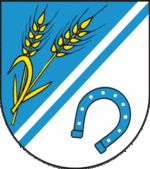Glebitzsch: Difference between revisions
Knorrepoes (talk | contribs) m (Text replacement - "/Arms of " to "/Arms (crest) of ") |
Knorrepoes (talk | contribs) m (Text replacement - "{{media}}" to " {{de1}} {{media1}}") |
||
| Line 26: | Line 26: | ||
The two wheat-ears and the horseshoe refer to the agricultural character of the two villages of Beyersdorf and Köckern. The horseshoe also refers to the historical shape of both villages. | The two wheat-ears and the horseshoe refer to the agricultural character of the two villages of Beyersdorf and Köckern. The horseshoe also refers to the historical shape of both villages. | ||
{{ | |||
{{de1}} | |||
{{media1}} | |||
[[Civic Heraldry Literature - Germany|'''Literature''']]: - | [[Civic Heraldry Literature - Germany|'''Literature''']]: - | ||
Revision as of 11:39, 26 December 2022
This page is part of the German heraldry portal |
Heraldry of the World |
|
German heraldry:
|
Selected collector's items from Germany:
|
GLEBITZSCH
State : Sachsen-Anhalt
District (Kreis) : Anhalt-Bitterfeld (until 2008 Bitterfeld)
Additions : 1950 Beyersdorf (1928 Julishof), Köckern
Incorporated into : 2009 Sandersdorf-Brehna
| German |
Von Blau und Silber schräglinks geteilt, die Teilung belegt mit einer in verwechselten Farben geschrägter Leiste; oben zwei goldene Ähren am Halm mit Blättern, unten ein mit den Stollen nach abwärts gekehrtes, nach der Teilung gestelltes blaues Hufeisen mit eckigen Nagellöchern. |
| English | No blazon/translation known. Please click here to send your (heraldic !) blazon or translation |
Origin/meaning
The arms were officially granted on ??-??-2005.
The two wheat-ears and the horseshoe refer to the agricultural character of the two villages of Beyersdorf and Köckern. The horseshoe also refers to the historical shape of both villages.
Literature: -


